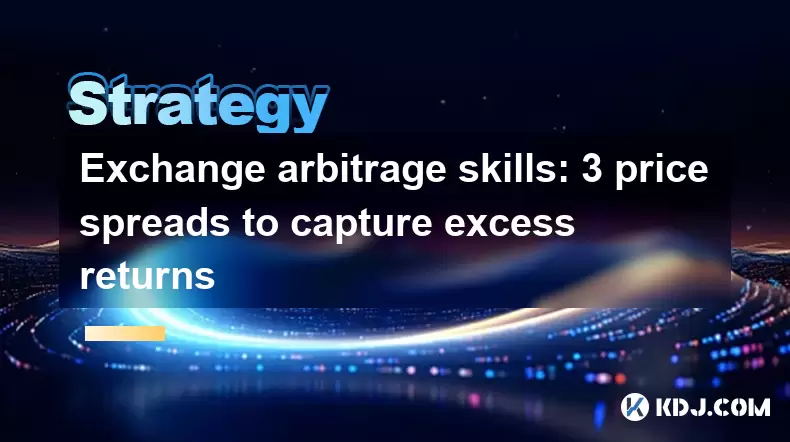-
 bitcoin
bitcoin $122090.672462 USD
1.59% -
 ethereum
ethereum $4493.758974 USD
0.56% -
 xrp
xrp $3.033145 USD
0.65% -
 tether
tether $1.000629 USD
0.00% -
 bnb
bnb $1169.854250 USD
7.07% -
 solana
solana $230.954786 USD
-0.19% -
 usd-coin
usd-coin $0.999785 USD
0.00% -
 dogecoin
dogecoin $0.256108 USD
-1.12% -
 tron
tron $0.342333 USD
-0.12% -
 cardano
cardano $0.859632 USD
-0.10% -
 hyperliquid
hyperliquid $48.932146 USD
-2.25% -
 chainlink
chainlink $22.345466 USD
-1.29% -
 ethena-usde
ethena-usde $1.000217 USD
-0.03% -
 avalanche
avalanche $31.203456 USD
1.93% -
 sui
sui $3.579145 USD
1.05%
Exchange arbitrage skills: 3 price spreads to capture excess returns
Exchange arbitrage involves buying low on one crypto exchange and selling high on another, using spatial, cross-exchange, and triangular methods for profit.
May 26, 2025 at 09:29 pm

Exchange arbitrage involves taking advantage of price differences for the same asset across different cryptocurrency exchanges. This strategy can be particularly lucrative in the volatile crypto market, where price discrepancies are common. In this article, we'll explore three specific price spreads that traders can use to capture excess returns through exchange arbitrage.
Understanding Exchange Arbitrage
Exchange arbitrage is the practice of buying a cryptocurrency on one exchange where the price is lower and simultaneously selling it on another exchange where the price is higher. The difference in price, known as the price spread, is the profit margin for the arbitrageur. This method requires quick execution and often involves automated trading systems to capitalize on fleeting opportunities.
To successfully engage in exchange arbitrage, traders need to have a solid understanding of the crypto market, access to multiple exchanges, and the ability to execute trades rapidly. Let's dive into three specific price spreads that can be exploited for excess returns.
Spatial Arbitrage
Spatial arbitrage involves exploiting price differences between different geographical regions. Cryptocurrency prices can vary significantly across regions due to factors such as local demand, regulatory environments, and liquidity levels.
To engage in spatial arbitrage, follow these steps:
- Identify price discrepancies: Use tools like CoinMarketCap or CryptoCompare to monitor prices across different exchanges globally.
- Select the right exchanges: Ensure you have accounts on the exchanges where the price discrepancies exist. Consider factors like fees, withdrawal limits, and trading volumes.
- Execute trades simultaneously: Buy the cryptocurrency on the exchange with the lower price and sell it on the exchange with the higher price. Use automated trading bots if possible to minimize execution time.
- Transfer funds: After selling on the higher-priced exchange, transfer the funds back to the original exchange or your wallet, accounting for transfer fees and times.
Spatial arbitrage can be highly profitable, especially in regions with less liquid markets where price discrepancies are more pronounced.
Cross-Exchange Arbitrage
Cross-exchange arbitrage is the most common form of arbitrage in the crypto space, involving the same asset listed on different exchanges. The goal is to profit from the temporary price differences that occur due to varying levels of liquidity and trading activity.
To perform cross-exchange arbitrage, follow these steps:
- Monitor multiple exchanges: Use real-time data feeds to track the prices of the same cryptocurrency across different platforms.
- Calculate potential profits: Consider all associated costs, including trading fees, withdrawal fees, and transfer times, to ensure the arbitrage opportunity is profitable.
- Execute trades quickly: Use trading bots or manual execution to buy and sell the cryptocurrency simultaneously on the different exchanges.
- Withdraw and transfer funds: After completing the trade, withdraw the funds from the higher-priced exchange and transfer them back to the original exchange or your wallet.
Cross-exchange arbitrage requires a keen eye for detail and the ability to act swiftly to capitalize on fleeting price differences.
Triangular Arbitrage
Triangular arbitrage involves exploiting price differences between three different cryptocurrencies on the same exchange. This method is more complex but can be highly profitable if executed correctly.
To engage in triangular arbitrage, follow these steps:
- Identify a triangular opportunity: Look for three cryptocurrencies (A, B, and C) where the exchange rates between them create a profitable loop. For example, if the exchange rate from A to B, B to C, and C back to A results in a profit, you have found a triangular arbitrage opportunity.
- Calculate the profit margin: Use the current exchange rates to determine if the triangular trade will result in a net profit after accounting for fees.
- Execute the trades in sequence: Buy cryptocurrency A with your base currency, then exchange A for B, B for C, and finally, C back to your base currency. Ensure all trades are executed quickly to capture the arbitrage opportunity.
- Monitor and adjust: Continuously monitor the exchange rates and be prepared to adjust your strategy if the market conditions change.
Triangular arbitrage can be more challenging to execute but offers the potential for significant returns, especially in markets with high volatility.
Tools and Technologies for Arbitrage
Successful arbitrage trading often relies on the use of advanced tools and technologies. Here are some essential tools that can help you capture excess returns:
- Arbitrage bots: Automated trading bots can monitor multiple exchanges and execute trades much faster than a human could. Examples include Gimmer and Blackbird.
- Real-time data feeds: Services like CryptoCompare and CoinAPI provide real-time price data, which is crucial for identifying arbitrage opportunities quickly.
- API integration: Many exchanges offer APIs that allow you to integrate your trading bots and monitoring tools directly with their platforms, enabling seamless execution of trades.
- Risk management software: Tools like CryptoTrader can help you manage your risk exposure and ensure that your arbitrage strategies remain profitable.
Using these tools can significantly enhance your ability to identify and capitalize on arbitrage opportunities in the crypto market.
Risks and Considerations
While exchange arbitrage can be highly profitable, it also comes with certain risks and considerations that traders must be aware of:
- Market volatility: Cryptocurrency markets are highly volatile, and price spreads can change rapidly, potentially turning a profitable opportunity into a loss.
- Transaction fees: High trading and withdrawal fees can erode your profit margins, so it's essential to factor these into your calculations.
- Execution risk: The time it takes to execute trades across different exchanges can impact your ability to capture the full price spread.
- Regulatory risks: Different jurisdictions have varying regulations around cryptocurrency trading, which can affect your ability to engage in arbitrage.
Understanding these risks and taking steps to mitigate them is crucial for successful arbitrage trading.
Frequently Asked Questions
Q: Can I perform exchange arbitrage manually, or do I need automated tools?A: While it is possible to perform exchange arbitrage manually, using automated tools can significantly increase your chances of success. Manual trading requires constant monitoring and quick execution, which can be challenging, especially in volatile markets. Automated tools like arbitrage bots can monitor multiple exchanges and execute trades much faster, helping you capture more opportunities.
Q: How do I calculate the potential profit from an arbitrage opportunity?A: To calculate the potential profit from an arbitrage opportunity, you need to consider the price spread between the exchanges, as well as all associated costs, including trading fees, withdrawal fees, and transfer fees. The formula for calculating profit is: Profit = (Sell Price - Buy Price - Total Fees). Ensure that the sell price is higher than the buy price plus all fees to ensure a profitable trade.
Q: Are there any legal restrictions on exchange arbitrage?A: Legal restrictions on exchange arbitrage can vary by jurisdiction. Some countries have strict regulations around cryptocurrency trading and may impose limits on arbitrage activities. It's essential to research and understand the legal environment in your region before engaging in arbitrage trading. Always comply with local laws and regulations to avoid potential legal issues.
Q: How can I minimize the risks associated with exchange arbitrage?A: To minimize the risks associated with exchange arbitrage, consider the following strategies: Use automated tools to execute trades quickly, diversify your arbitrage opportunities across multiple assets and exchanges, keep a close eye on market volatility, and factor in all associated costs to ensure profitable trades. Additionally, stay informed about regulatory changes that could impact your trading activities.
Disclaimer:info@kdj.com
The information provided is not trading advice. kdj.com does not assume any responsibility for any investments made based on the information provided in this article. Cryptocurrencies are highly volatile and it is highly recommended that you invest with caution after thorough research!
If you believe that the content used on this website infringes your copyright, please contact us immediately (info@kdj.com) and we will delete it promptly.
- BlockDAG, DOGE, HYPE Sponsorship: Crypto Trends Shaping 2025
- 2025-10-01 00:25:13
- Deutsche Börse and Circle: A StableCoin Adoption Powerhouse in Europe
- 2025-10-01 00:25:13
- BlockDAG's Presale Buzz: Is It the Crypto to Watch in October 2025?
- 2025-10-01 00:30:13
- Bitcoin, Crypto, and IQ: When Genius Meets Digital Gold?
- 2025-10-01 00:30:13
- Stablecoins, American Innovation, and Wallet Tokens: The Next Frontier
- 2025-10-01 00:35:12
- NBU, Coins, and Crypto in Ukraine: A New Yorker's Take
- 2025-10-01 00:45:14
Related knowledge

Practical parameter settings for a Bitcoin multi-timeframe moving average system
Sep 18,2025 at 10:54pm
Optimizing Timeframe Combinations for Bitcoin Trading1. Selecting appropriate timeframes is crucial when building a multi-timeframe moving average sys...

How can I filter out false breakouts in Dogecoin high-frequency trading?
Sep 22,2025 at 01:00am
Understanding False Breakouts in Dogecoin Trading1. A false breakout occurs when Dogecoin's price appears to move beyond a defined support or resistan...

Techniques for identifying tops and bottoms in the Bitcoin on-chain NVT model
Sep 20,2025 at 07:54pm
Understanding the NVT Model in Bitcoin Analysis1. The Network Value to Transactions (NVT) ratio is often described as the 'P/E ratio' of the cryptocur...

What does the surge in open interest in Bitcoincoin futures mean?
Sep 20,2025 at 11:18pm
Understanding the Surge in Dogecoin Futures Open Interest1. A surge in open interest within Dogecoin futures indicates a growing number of active cont...

How can I use the Ethereum USDT premium to gauge market sentiment?
Sep 18,2025 at 11:55pm
Understanding the Ethereum USDT Premium1. The Ethereum USDT premium refers to the price difference between USDT (Tether) traded on Ethereum-based plat...

What should I do if Ethereum staking yields decline?
Sep 20,2025 at 06:18am
Understanding the Causes Behind Declining Ethereum Staking Yields1. The Ethereum network transitioned to a proof-of-stake consensus mechanism with the...

Practical parameter settings for a Bitcoin multi-timeframe moving average system
Sep 18,2025 at 10:54pm
Optimizing Timeframe Combinations for Bitcoin Trading1. Selecting appropriate timeframes is crucial when building a multi-timeframe moving average sys...

How can I filter out false breakouts in Dogecoin high-frequency trading?
Sep 22,2025 at 01:00am
Understanding False Breakouts in Dogecoin Trading1. A false breakout occurs when Dogecoin's price appears to move beyond a defined support or resistan...

Techniques for identifying tops and bottoms in the Bitcoin on-chain NVT model
Sep 20,2025 at 07:54pm
Understanding the NVT Model in Bitcoin Analysis1. The Network Value to Transactions (NVT) ratio is often described as the 'P/E ratio' of the cryptocur...

What does the surge in open interest in Bitcoincoin futures mean?
Sep 20,2025 at 11:18pm
Understanding the Surge in Dogecoin Futures Open Interest1. A surge in open interest within Dogecoin futures indicates a growing number of active cont...

How can I use the Ethereum USDT premium to gauge market sentiment?
Sep 18,2025 at 11:55pm
Understanding the Ethereum USDT Premium1. The Ethereum USDT premium refers to the price difference between USDT (Tether) traded on Ethereum-based plat...

What should I do if Ethereum staking yields decline?
Sep 20,2025 at 06:18am
Understanding the Causes Behind Declining Ethereum Staking Yields1. The Ethereum network transitioned to a proof-of-stake consensus mechanism with the...
See all articles










































































